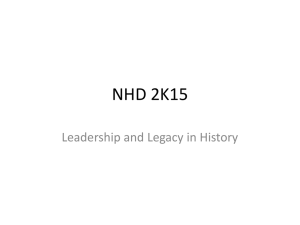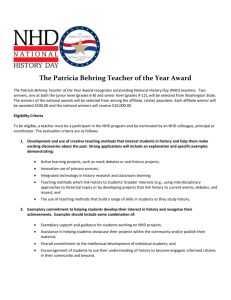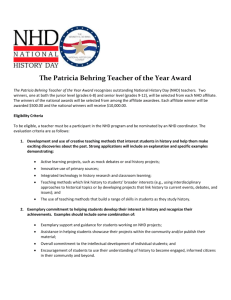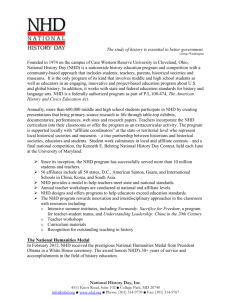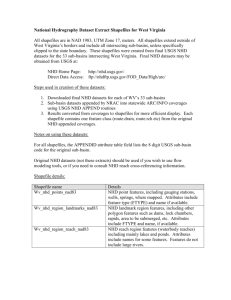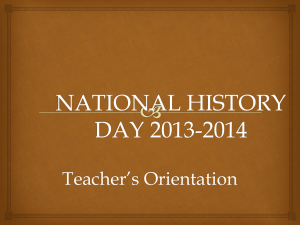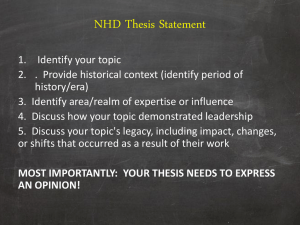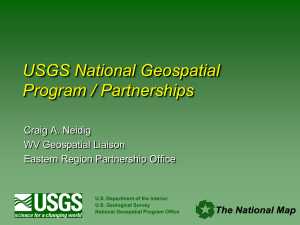HDWG_OWDI_NHD_Rea20140814
advertisement
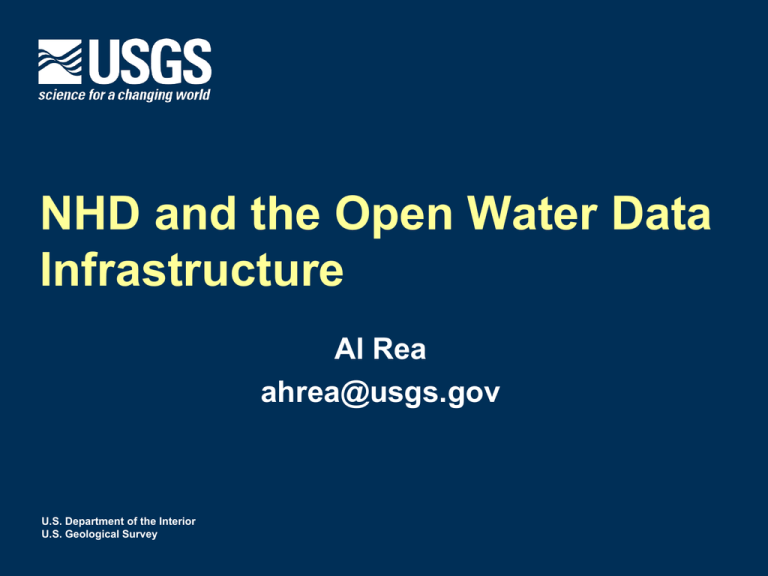
NHD and the Open Water Data Infrastructure Al Rea ahrea@usgs.gov U.S. Department of the Interior U.S. Geological Survey What is the National Hydrography Dataset? Essentially the surface water features found on topographic maps The fundamental component is the drainage network of rivers and streams 7.5-million mile network Completing the network through waterbodies Completing the network through waterbodies with artificial paths 6.5 million waterbodies Attributes provide basic intelligence Perennial Swan Creek Intermittent Ephemeral Flow Direction – A key piece of intelligence Navigation – The basis for analysis Linear Referencing – Stream “Reaches” Reach 14010002000421 Reach 14010002003345 Linear Referencing – Stream addresses 14010002000421 0 50 25 100 75 Linear Referencing – Data “Events” USGS Streamgage 09050000 Coordinate 106 05 13.955 W 39 32 43.472 N Address: Reach – 14010002000421 Measure – 19.8392 Connecting the streamgage to the network Blue River Artificial Path (Blue River) Streamgage Dam Green Mountain Reservoir Adding geospatial context to streamflow data Dams and Streamgages Integrated with the NHD Analyzing Relationships Identifying diversions upstream of a streamgage Easily accomplished with a good database and a GIS Gage Diversions Common Hydrographic Frames of Reference RF-1 1:500,000 scale Developed in 1980’s National or large regional studies/models Medium-Resolution NHD 1:100,000 scale Completed 2001 Basis of NHDPlus Regional studies/models High-Resolution NHD Multi-scalar, 1:24,000 scale or better Nationally complete 2007 Current maintenance, many improvements NHDPlus provides a Surface Water Geospatial Framework Elevation NHDPlus catchments link the landscape to the stream network forming a surface water geofabric Hydrologic Units (HUC12) Stream Network Stream Network Total Stream Miles (mi) Stream Segment Average Length (mi) # of Lakes Catchment Average Area (sq mi) 60,000 10 4,100 50 3,200,000 2,600,000 1.2 38,000 1.1 7,500,000 20,000,000 0.37 537,000 do not exist Map Scale Map Accuracy Reach File Version 1 (RF1) 1:500K +/- 254m 600,000 Medium Resolution NHD 1:100k +/- 50m 1:24K or better +/- 12m High Resolution NHD # of Stream Segments EPA WATERS Data: Internal Access Only Public Access • Drinking Water Intakes • Listed Impaired Waters • Source Water Areas • Assessed Waters • Special Appropriations Projects • Beaches • Clean Watershed Needs • Combined Sewer Overflows • CWSRF Benefits Reporting • Permitted Dischargers ~ • Fish Consumption Advisories • Fish Tissue Data • Impaired Waters with TMDLs • Sewage No Discharge Zones • Nonpoint Source Projects • Water Quality Standards • Water Quality Stations 6,000,000 events tied to 100K NHD HR NHD Type 1, Gaging Station: 127,659 HR NHD Type 6, Water Quality Station: 93,787 HR NHD Type 2, Dam: 60,311 Point Events in NHD March 4, 2014 Type 1 Gaging station 127,659 2 Dam 60,311 3 Divergence Structure = General 25 4 Divergence Structure = Withdrawing 1,236 5 Divergence Structure = Contributing 63 6 Water Quality Station 93,787 ALL 283,081 23 A Single Hydrographic Frame of Reference Based on High-Res NHD Single addressing system Single dataset to maintain High-Res NHDPlus Currently in development Network Value Added Attributes (VAA’s), catchments, rasters, flow estimates Generalization scheme Several generalized scales based on High-Res NHD NHDPlus derivatives for each scale Existing web services (EPA WATERS NHDPlus 100K-based) EPA WATERS Web and Database services Event indexing Point indexing Name service Navigation service Navigation delineation service RAD event info service Lookup services Results queue service Spatial assignment service Incremental Cumulative HEM Web Initial Release Release date – April 30th, 2014 SOE HiRes NHD Read-Only Web Map Service (AGS) National Coverage Updated Daily Enables display/query and snapping Sample JavaScript API Code Configuration Documentation http://nhd.usgs.gov/tools.html#hem Contact: hem@usgs.gov June 26, 2014 Steering Committee Meeting Open Water Data Initiative Kevin T. Gallagher USGS, Associate Director, Core Science Systems Open Water Data Vision Foundational National Data Sets with Data Services to support a wide variety of water user applications Water data metadata, web services and a community accessible on the Federal Geospatial Platform Access to integrated real-time monitoring data Data Assimilation for a National Modeling capability Water Maps and other Derivative Products that integrate geospatial & water observations Such as: current conditions, precipitation estimates, reservoir storage Marketplace of open source applications (models, data visualizations, etc.) built upon Open Water Web Services 30 Foundational Water Data Sets Streamflow Groundwater levels Aquifers Water quality Reservoir storage Elevation Hydrography – NHD/WBD Landscape Variables Climate/Weather/ET Soil moisture Human water use Withdrawals Return flows Diversions Losses 31 ACWI – Advisory Committee on Water Information Established in 1991 Proposal We are proposing an Open Water Data Initiative that will: integrate currently fragmented water information into a connected, national water data framework leverage existing shared infrastructure and tools to provide a platform for innovation, modeling, and data sharing and solution development. capitalize on cross-government interest in big data, IT innovation, Open Data, Data.gov, etc. Build on the ground-breaking work of the FGDC, OGC, IWRSS, CUASI, ACWI, and others. 33 Charge for the FGDC In collaboration with the ACWI and other partners – Advance an Open Water Data Initiative, including: Reviving and populating the joint Subcommittee on Spatial Water Data to design a national open water data infrastructure; Supporting IWRSS consortium members in the scoping and implementation pilot activities; Creating an integrated water data portfolio for specific hydrologic regions or basins; Developing a technical reference architecture that supports the sharing of water data and links observations to geospatial data; Leveraging the Geospatial Platform to make water data more accessible and to support water data community collaboration; 34 Charge for the FGDC cont. Identifying how existing investments in water data sharing can be integrated and leveraged; Engaging the international community in standards and technology development including the Open Geospatial Consortium; Identifying and prioritizing improvements to relevant framework geospatial data (National Hydrographic Dataset, Watershed Boundary Dataset, National Elevation Dataset, National Geologic Map Database, and the National Cooperative Soil Survey); Utilizing the FGDC coordination and governance structure to support related activities in the federal water sector. 35 Next Steps Endorse revival and re-populating of Subcommittee on Spatial Water Data Issue charge to the subcommittee Work with IWRSS consortium members to: Refine charge going forward Define and implement Pilot Projects Schedule “periodic” check-ins with the Steering Committee 36 Use Cases NFIE Short Term Networks/temporary gages (Marie Peppler) Data from Sandy, other floods Project underway now Can exercise the services Main goal: NHD indexing (events) Secondary goal: navigation, event discovery Hydro Geospatial Fabric/National Hydrology Model (Roland Viger) West Virginia chemical spill West Virginia Chemical Spill Spill one mile upstream from water treatment plant Incident Command Tool for Drinking Water Protection (ICWater) used to warn downstream water suppliers Uses NHDPlus flows and velocities Adjusts with real-time gage data Provided accurate travel-time estimates Protected Cincinnati water supply and others Measured velocity Intake Spill site Model velocity Downstream trace Spill site Intakes near Cincinnati 120 hours Potential Future NHD Services Expose most/all data as features/related tables Up/Downstream navigation with event discovery Event clearinghouse(s) Open – federated catalog Service-based Discoverable Initial hosted community via ScienceBase Event management services Event synchronization Event migration between scales What services are needed for NFIE? Do WATERS services do everything needed? Event indexing Up/Downstream navigation? Others? Does NFIE need to reference any network other than NHDPlus? What supporting services are needed? WFS? Which features? WCS for elev? 2D to 3D line service? What are recommended processes? Scoping of pilots? Development of standards?
